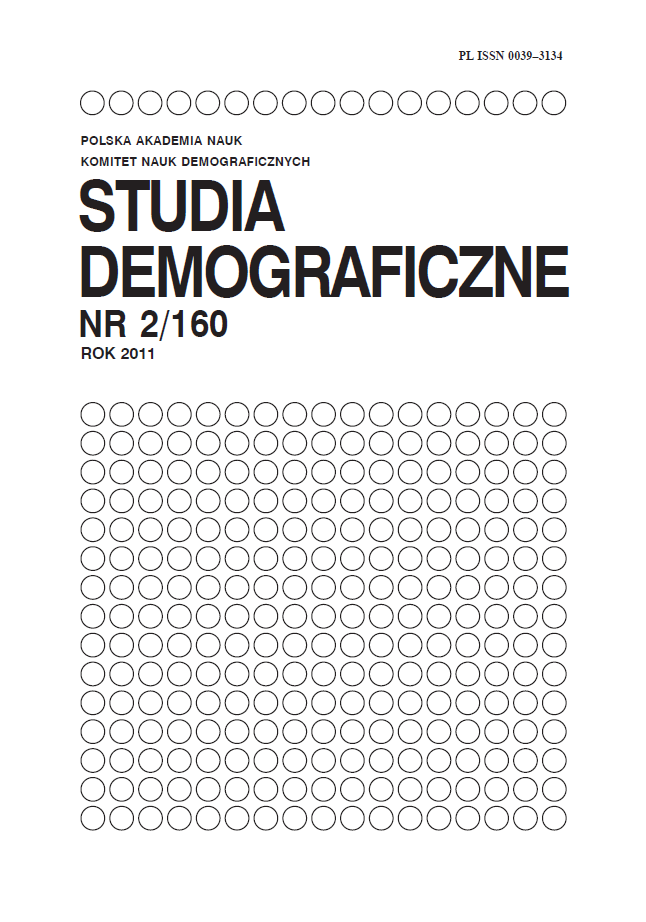Oszacowanie rzeczywistej liczby ludności gmin województwa mazowieckiego z wykorzystaniem danych ZUS
Main Article Content
Abstract
The article presents the problem of lack of compliance with population registration requirements, in relation to the factual place of residence. This problem persists in Poland due to the reliance of official statistics on the data on current registrations, and also due to adoption of the legal, rather than factual definition of residence. To estimate the extent of this phenomenon for Mazovia voivodship, the data of the Social Insurance Institution (ZUS) are used, which enable a comparison of the addresses of permanent residence with the address for correspondence of the insured persons. Depending on the age group, the identified differences were quite high, especially for the most mobile ages (e.g. over 9% for people aged 27 years). Spatial concentration was also shown, especially with respect to underestimation of the true population of Warsaw and its suburban areas, and overestimation for peripheral regions. In many communes the problem of non-compliance with registration requirements concerns over 10% of the registered population. This limits the scope of demographic analyses, especially in the context of their practical applications and population projections.
Article Details
References
[2] Broemeling A-M., Kerluke K., Black Ch., Peterson S., MacDonald A., McKendry R., 2009, Developing and Maintaining a Population Research Registry to Support Primary Healthcare Research, „Healthcare Policy”, vol. 5, Special Issue, 65–76.
[3] Christenson M., 2006, The official U.S. Census Bureau population estimates by demographic characteristics: Requirements, evaluation, and future directions, Paper presented at the Population Association Annual Meeting, Los Angeles, California, http://paa2006.princeton.edu/download.aspx?submissionId=60206.
[4] Eichenberger P., Potterat, J., Hullinger, B., 2010, Describing the anticipated accuracy of the Swiss Population Survey, Federal Statistical Office, Switzerland.
[5] GUS, 2012, Wyniki Narodowego Spisu Powszechnego Ludności i Mieszkań 2011. Podstawowe informacje sytuacji demograficzno-społecznej ludności Polski oraz zasobach mieszkaniowych, Główny Urząd Statystyczny, Warszawa (opracowanie przygotowane na II Kongres Demograficzny w dniach 22–23 marca 2012 r.).
[6] GUS, 2011, Informacja o rozmiarach i kierunkach emigracji z Polski w latach 2004–2010, Departament Badań Demograficznych GUS, Warszawa.
[7] Iglicka K., 2011, Migracje długookresowe i osiedleńcze z Polski po 2004 roku – przykład Wielkiej Brytanii. Wyzwania dla statystyki i demografii Państwa, „Raporty i Analizy”, z. 5, Centrum Studiów Międzynarodowych.
[8] Jagielski A., 1978, Geografia ludności, PWN, Warszawa.
[9] Korcelli P., 1997, Alternatywne projekcje zmian demograficznych i migracji w aglomeracjach miejskich, [w:] P. Korcelli (red.), Aglomeracje miejskie w procesie transformacji: Zeszyty IGiPZ PAN 45, IGiPZ PAN, Warszawa, s. 5–22.
[10] Korcelli P., Potrykowska A., 1988, Redistribution of the elderly population in Poland: regional and rural-urban dimensions, „Geographia Polonica”, vol. 54, 121–138.
[11] Kowalski M., Śleszyński P., 2010, Migracje Polaków do Niemiec w świetle częstotliwości występowania najbardziej popularnych polskich nazwisk, „Przegląd Zachodni”, t. 66, z. 2, 115–130.
[12] Kruszka K. (red.), 2010, Dojazdy do pracy w Polsce. Terytorialna identyfikacja przepływów ludności związanych z zatrudnieniem, Ośrodek Statystyki Miast Urzędu Statystycznego w Poznaniu, Poznań.
[13] Kupiszewski M., Bijak J., 2006, Ocena prognozy ludności GUS 2003 z punktu widzenia aglomeracji warszawskiej, „CEFMR Working Paper”, z. 1/2006, Środkowoeuropejskie Forum Badań Migracyjnych, Warszawa.
[14] Li S., Zhang Y., Feldman M.W., 2010, Birth Registration in China: Practices, Problems and Policies, „Population Research and Policy Review”, vol. 29, Issue 3, 297–317.
[15] Ludvigsson J.F., Otterblad-Olausson P., Pettersson B.U., Ekbom A., 2009, The Swedish personal identity number: possibilities and pitfalls in healthcare and medical research, „European Journal of Epidemiology”, vol. 24, no 11, s. 659–667.
[16] Matthijs K., Moreels S., 2010, The Antwerp cor*-database: A unique Flemish source for historicaldemographic research, „The History of the Family”, vol. 15, issue 1, 109–115.
[17] Okólski M., 2004, Demografia zmiany społecznej, Wydawnictwo Naukowe Scholar, Warszawa.
[18] Paradysz J. (rec.), 2004, Marek Kupiszewski, Modelowanie dynamiki przemian ludnościowych w warunkach wzrostu znaczenia migracji międzynarodowych, Wydawnictwo PAN, IGiPZ, Prace Geograficzne nr 181, Warszawa 2002, s. 174, „Studia Demograficzne”, nr 1/145, 129–133.
[19] Ralphs M., Tutton B., 2011, Beyond 2011: International models for census taking: current processes and future developments, Beyond 2011 Project. Office for National Statistics, London.
[20] Rykiel Z., 1986, Ograniczenia meldunkowe jako bariery przestrzenne, „Przegląd Geograficzny”, nr 3/58, 395–409.
[21] Sakson B., 1998, Szacunek rzeczywistej liczby Polaków, którzy opuścili kraj w latach 1981–1989 na podstawie danych Systemu Ewidencji Ruchu Paszportowego, „Studia Demograficzne”, nr 1/131, 27–66.
[22] Sakson B., 2000, Oszacowanie liczby i struktury ludności Polski w dniu 6.12.1988 z uwzględnieniem migracji lat 80., „Studia Demograficzne”, nr 1/137, 53–97.
[23] Suseł A., Jasieńska G., 2010, Determinanty płodności kobiet w Stanach Zjednoczonych: przegląd wyników badań, „Zdrowie Publiczne i Zarządzanie”, z. 2, s. 101–108.
[24] Śleszyński P., 2004a, Regionalne różnice pomiędzy liczbą ludności według Narodowego Spisu Powszechnego w 2002 roku i szacowaną na podstawie ewidencji bieżącej, „Studia Demograficzne”, nr 1/145, 93–103.
[25] Śleszyński P., 2004b, Różnice liczby ludności wykazane w NSP 2002 – suplement, „Studia Demograficzne”, nr 2/146, 104–109.
[26] Śleszyński P., 2005, Różnice liczby ludności ujawnione w Narodowym Spisie Powszechnym 2002, „Przegląd Geograficzny”, nr 2/77, 193–212.
[27] Tønder, J.-K., 2008, The register-based statistical system: Preconditions and processes, International Association for Official Statistics Conference, Shanghai.
[28] Watson D.E., Peterson S., Young E., Bogdanovic B., 2009, Methods to Develop and Maintain a Valid Physician Registry in Evolving Information Environments, „Healthcare Policy”, vol. 5, Special Issue, 77–90.
[29] Williamson L., Norman P., 2011, Developing strategies for deriving small population fertility rates, „Journal of Population Research”, vol. 28, 129–148.
[30] Woods S., 2008, Evaluating population estimates in the United States: Counting the population between the censuses, „Government Information Quarterly”, vol. 26, 144–147.
[31] ZUS, 2011, Zasady podlegania ubezpieczeniom społecznym i ubezpieczeniu zdrowotnemu, ustalania podstawy wymiaru oraz rozliczania i opłacania składek na te ubezpieczenia oraz na Fundusz Pracy i Fundusz Gwarantowanych Świadczeń Pracowniczych. Poradnik, Zakład Ubezpieczeń Społecznych, Warszawa.
